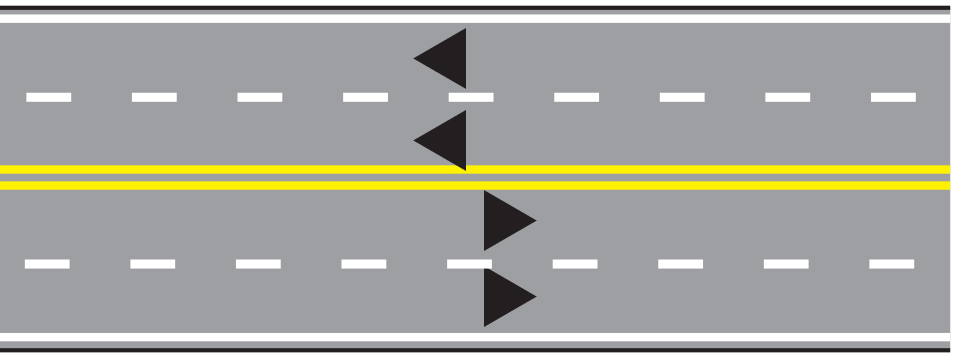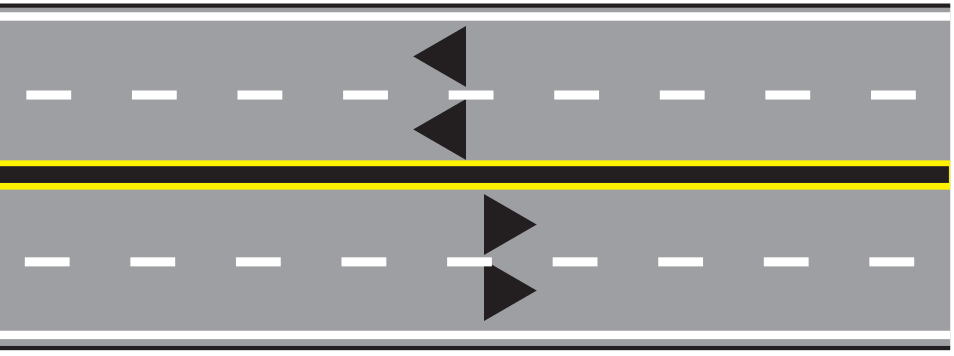Which Of The Following Are Used As Left-edge Lines On Divided Highways?
Page Content
Pavement Markings
Most roads have permanent markings to show the center of the road, travel lanes, or road edges. The markings that show the heart of the road are solid or broken lines. These pavement markings also indicate special lane use. Xanthous lines divide traffic traveling in contrary directions. Yellow lines are used to mark the center of ii-lane roads, and to mark the left edge of divided highways, one-way streets, and ramps. Solid white lines split up lanes of traffic traveling in the aforementioned direction. Solid white lines are also used to marker the correct edge of the road.
As a general rule, broken traffic lines tin be crossed and solid lines cannot, except when making a turn.
Some examples of dissimilar pavement markings and their meanings follow:

A single, broken yellow centerline shows the eye of a two-way, two-lane road. Passing is permitted on either side, if safe conditions exist. When passing, yous must use the lane belonging to oncoming traffic.

A double, solid yellow centerline shows the center of a two-style road. Even if information technology is not marked with a NO PASSING sign, passing by traffic traveling in either direction is not allowed on roads marked in this fashion.

The combination of a solid yellow and a broken xanthous centerline too shows the center of a two-style roadway. You may pass if the broken line is on your side of the road and safe weather condition exist, but y'all may not pass when a solid yellow line is on your side of the route.

Mark patterns similar these may be found on many three-lane or five-lane highways. The outside, solid yellowish centerline means you lot cannot use the center lane for passing. The inside, broken yellowish and solid xanthous centerlines testify vehicles traveling in either direction may use the heart lane only to make left turns. Refer to Affiliate 3 for more information nigh using center turn lanes safely.

Multi-lane highways without medians (center dividers) are ofttimes marked equally shown. Broken white lines show which lanes can be used past vehicles traveling the same style. You may cantankerous the broken white lines to pass, (be certain the passing lane is clear) merely y'all may not cross the double yellow centerlines to pass. Traffic is traveling in the opposite direction in the lane to the left of the yellow centerline.

This pattern is used on most express access highways with medians (center dividers). The right edge of the road is marked with a solid white line. The left edge of each side is marked by a solid yellowish line. The traffic lanes for each side are marked by broken white lines, which may be crossed.
Pavement markings also include words painted on the pavement and arrows that supplement messages posted on regulatory and warning signs. Examples include the words STOP AHEAD earlier an intersection with a Stop sign, YIELD or white triangles painted beyond the lane to betoken you must yield to approaching traffic, SCHOOL earlier a school zone, R X R before a railroad crossing, Bicycle LANE for a lane reserved for bicyclists, ONLY with a left or right arrow to indicate the lane is reserved for turns just and large white arrows to signal the direction of travel on 1-way streets and highway off-ramps.
Which Of The Following Are Used As Left-edge Lines On Divided Highways?,
Source: https://www.dmv.pa.gov/Driver-Services/Driver-Licensing/Driver-Manual/Chapter-2/Pages/Pavement-Markings.aspx
Posted by: harkinshicle1975.blogspot.com


0 Response to "Which Of The Following Are Used As Left-edge Lines On Divided Highways?"
Post a Comment